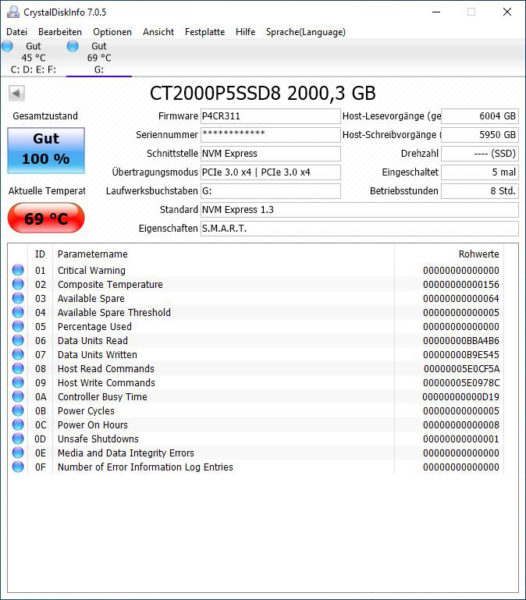
Here are the technical data according to manufacturer …
| Manufacturer | Crucial |
| Article number | CT2000P5SSD8 |
| Capacity | 2000GB (NAND) |
| Interface | PCIe 3.0 x4 NVMe |
| Cache | 16GB (512M x 32) 2133MHz LPDDR4 DRAM |
| Controller | Micron DM01B2 |
| Flash Type | Micron 96 Layer 3D TLC NAND – Triple-Level-Cell |
| Size | M.2 2280 (80 x 22 x 3.5mm) |
| Weight | ca. 10 Gramm |
| Speed | Read up to 3400MB/s / write up to 3000MB/s |
| MTBF | 1,8 million hours, 1200 TB total bytes written (TBW), equal to approx. 657 GB per day for 5 years. |
| Miscellaneous | SMART Support – Self-Monitoring and Reporting Technology, TRIM Unterstützung, RAIN (Redundant Array of Independent NAND), Dynamic Write Acceleration, APST (NVMe Autonomous Power State Transition), Adaptive Thermal Protection, Active Garbage Collection, Integrated Power Loss Immunity, Multistep Data Integrity Algorithms and ECC (Error Correction Code). |
Here is a screenshot of the CrystalDiskInfo SSD and hard disk information software. The Crucial SSD has been equipped with a temperature sensor, as with the previous Micron SSDs, which can be queried correctly under Microsoft Windows 10. Alternatively the Crucial SSD temperature can be queried with the Crucial Storage Executive software. Idle temperatures above 40°C and load temperatures clearly above 50°C aren’t uncommon in M.2 SSDs, as you can see here after some benchmarks. We’ll return to the maximum NVMe temperature in the practical testing page.

Crucial P5 2TB M.2 NVMe Layout, design and features …

